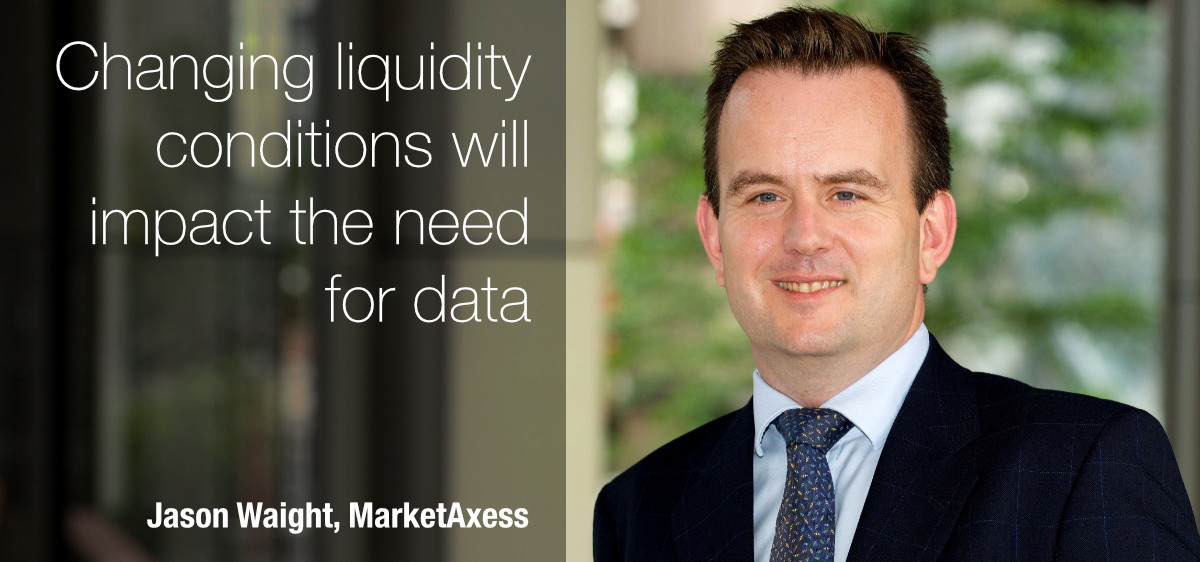
Data demands change as liquidity ebbs and flows, creating risks for buy-side traders as they seek to use more data to support their activity and increased levels of automation. Jason Waight, Head of Regulatory Affairs, Europe at MarketAxess outlines the challenges to The DESK.
When market conditions change, both price transparency and liquidity are affected; traders need to optimise their access to price and liquidity data. That can mean increasing access to available data, or enhancing the analytics used to support risk and investment processes.
How do market conditions affect transparency demands?
There is always as strong demand for transparency – the fixed income market has a lot of bonds which trade infrequently, so any data point you can get is in demand, whatever the market conditions.
When market conditions are more stressed, it becomes more important to discover as many data points as you can, to try and understand the appropriate level for trading. A bifurcation can occur in crisis situations, whereby you might see a lot more transparency in bonds that are suddenly very active. You may see a string of information because there is a lot of activity, and therefore it becomes safe for us to publish it under our rules.
But you may also see the opposite effect. Liquidity can dry up and it becomes harder to find any price point. So, there isn’t a straightforward reaction. The key argument for a consolidated tape is to counter that problem.
As firms make prices how does their need for transparency change?
We can see more firms becoming price makers on our platforms. I am confident that correlates nicely with the availability of more data. It’s hard to make prices without data. In the crisis earlier this year, we saw a step up in the number of participants on our all-to-all platform making prices, Open TradingTM. We have seen them stay, and that is not possible without access to the kind of data to work out where to price.
Do you need a critical mass of data before you are confident enough to make a price?
That’s got to be the case. In practice, the biggest barrier to price making is not so much access to information, because you can get that, it’s having the time to calculate where the market is, and then to engage with your portfolio manager about whether they are happy or not with making a price. The barriers I can see are more to do with timing than with information that is available. If you come onto our platform you can see our Composite Plus (CP+) pricing tool with Axess All.
What is the correlation between executable liquidity and price transparency?
 The relationship is not linear. Transparency and liquidity clearly support each other up to a point. There is a balance whereby there is enough liquidity to support transparency, the point at which people are comfortable taking risk and there is enough information to make prices. But clearly at one point on the curve the correlation might invert, and too much transparency prevents people from taking risk.
The relationship is not linear. Transparency and liquidity clearly support each other up to a point. There is a balance whereby there is enough liquidity to support transparency, the point at which people are comfortable taking risk and there is enough information to make prices. But clearly at one point on the curve the correlation might invert, and too much transparency prevents people from taking risk.
Figuring out the exact at which that happens is hard. ESMA has spent a lot of time trying to do that. The relationship is correlated up to a point, after which I suspect it inverts and the correlation becomes potentially negative.
There are different views as to the right level of transparency on the buy-side. The number of buy-side firms that are starting to make prices this year on Open Trading is increasing, suggests they are confident in the greater amount of data they are getting, and what they are doing. There is also evidence that suggests the buy-side traders want a consolidated tape for more transparency, and the International Capital Markets Association (ICMA) is working with buy and sell side to try and standardise axe distribution, so clearly how axes and dealer runs are presented is causing problems which needs sorting out.
If they want to increase confidence, what steps can they take?
It comes down to reviewing sources, making sure that they are as wide as they can possibly be. That could include traded prices as we provide via services like Axess All, which truly acts as the first intra-day tape for the European fixed income markets. Other products like CP+ take into account not only trade prints, but data reports, quotes and other information that can be consolidated. They need a clear view of where they are sourcing data from and need to maximise the amount that they can get.
How would that then affect their capacity to find a counterparty in different market conditions?
The more confident you are in your data, the more open you can be in using trading protocols such as Open Trading, which opens up the entire universe of liquidity providers on the MarketAxess platform. That to me is the real correlation of the link between data and liquidity.
Historically, relationships led a trader from trusting a dealer to thinking their price would be good. Today, if you have the data you can know where the price is going to be, and I ask the dealer for it.
How do you expect trading to change as an outcome of more data-led trading activity?
An increase in the non-standard counterparties that you see trading on platforms. If you haven’t got bilateral relationships, platforms provide a route to access those non-traditional counterparties, with pricing data taking the place of the need to trust a human being on the other side.
Open Trading’s success is that it enables you to face a counterparty in MarketAxess and can get access to the full range of liquidity that they can provide, and if you have got the pricing tool you can be pretty confident in how you are evaluating it.
What would you say are the most effective approaches to onboarding data of the right quality and amount, and integrating that in the buy side desks today?
People have data resources that are under utilised. And the vast majority of firms can access most of our pricing products, but a number don’t. So, my main call to action would be to ask firms to take a good look at what they already have access to. You may find there is more information available to you than you realise.

©Markets Media Europe 2025












